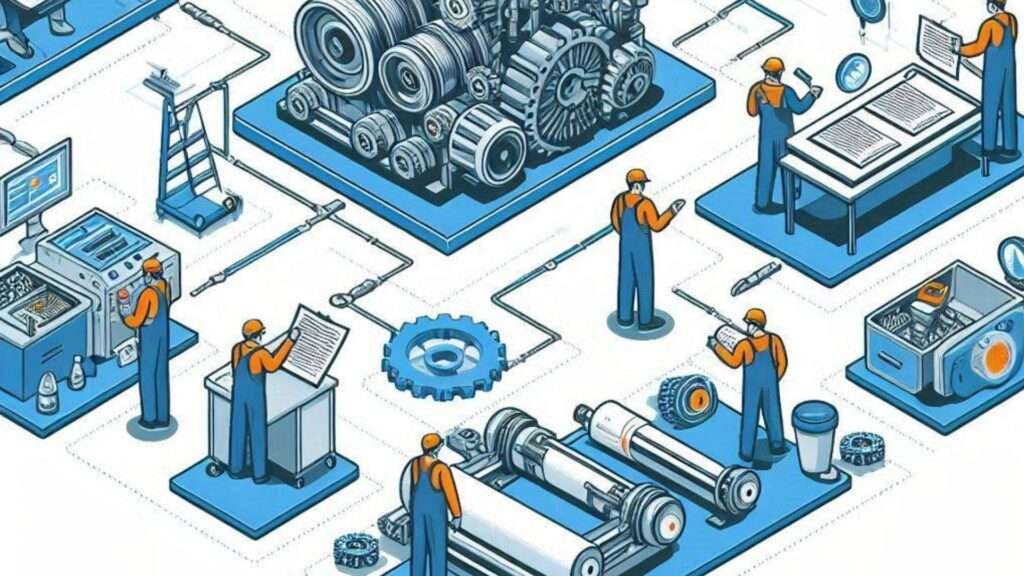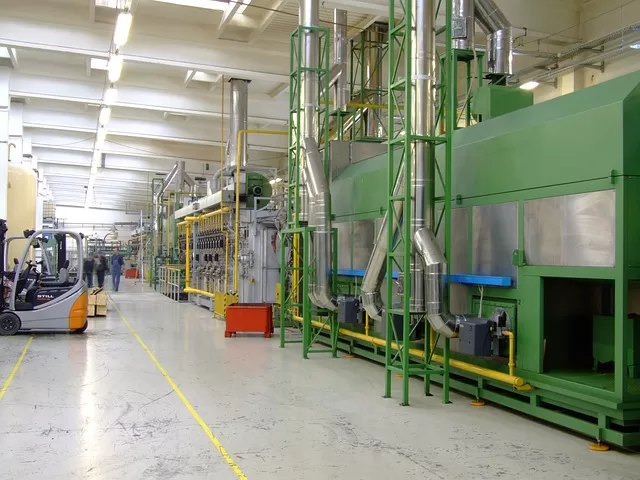The 5 Step Maintenance Systems Audit Process.
The 5-Step Maintenance Systems Auditing Process is a
comprehensive approach to assessing the effectiveness and efficiency of a
company’s maintenance department.
These audits seek to identify areas for improvement by
systematically examining practices, procedures, and performance metrics,
ensuring that the maintenance department operates at its full potential.
The primary goals of performing maintenance systems audits are
to validate compliance with established standards, identify potential risks and
inefficiencies, and develop actionable recommendations to improve overall
performance.
The auditing process entails a thorough evaluation of various
aspects, including maintenance planning, scheduling, execution, and reporting.
It also examines resource allocation, adherence to safety
protocols, and departmental communication effectiveness.
Maintenance system audits help organisations make informed
decisions, prioritise resource allocation, and implement best practices by
providing a clear and objective evaluation.
Master data analysis is an important part of the auditing
process. Master data contains all of the necessary information about the
maintenance assets, such as equipment specifications, asset hierarchies, maintenance
strategies, bills of materials, asset criticality determinations and maintenance
vendor details.
Accurate and up-to-date master data is essential for making
sound decisions because it provides a comprehensive picture of the asset’s
criticality, functional purpose, condition, and performance.
In the context of maintenance systems, master data serves as
the foundation for purchasing, strategy development, work initiation, planning,
scheduling, and maintenance work execution, ensuring that the right amount of
the right resources are available at the right time and for the right reasons.
Maintenance systems auditing is critical for increasing the
efficiency and effectiveness of a company’s maintenance department and regular
audits provide timely and valuable insights into their ability to consistently
perform in the best interests of the company.
Understanding
The Value Of Asset Master Data in Maintenance.
Asset Master Data Management (AMDM) is an essential component
of modern business operations, driving many maintenance department decisions
and serving as the foundation for managing and optimising an organization’s diverse and
business critical assets.
Asset master data refers to a comprehensive set of data points
that describe and categorise an
organization’s physical and digital assets.
Asset data points typically include asset type, manufacturer, serial
number, arrangement, operating capacity, material specification, weight,
dimensions, bills of materials, acquisition date, criticality designation, maintenance
strategy and other important technical data.
The importance of Master Data Specialists in a company’s
organisation cannot be overstated because they ensure that asset data points
are maintained, ensuring that this information is correct, consistent, approved
and easily accessible to maintenance system users.
Approved, accurate, consistent, and easy-to-access asset
master data is important for a variety of reasons, the most important of which
is that it allows CMMS/Asset Management System users to rely on the data to be
correct and, as a result, make critical decisions, some of which may require
significant company expenditure.
Regular auditing of Asset Master Data allows organisations to
keep an eye on their foundation data and ensure that the Master Data
Specialists are keeping this information up to date; for companies that do not
employ these roles, ensure that master data updates are performed on a regular
basis.
When Asset Master Data is accurate and consistent, it improves
compliance with statutory and regulatory requirements, as well as
industry-specific standards, lowering the risk of legal and financial
penalties.
When system users can generate reports, queries, or other
compliance-related data using standardised maintenance
dashboard functions, virtually any maintenance department employee can
produce highly important information for regulators in minutes.
Asset Master Data Specialists and others who regularly update
asset master data can prevent unwanted data
silos from forming within an organisation by providing a single and
reliable source of truth for critical asset information. This reduces the
likelihood of costly errors caused by duplicate appearance data that turns out
to be inaccurate.
This, in turn, simplifies tasks such as maintenance planning,
scheduling, asset analysis, predictive maintenance, and lifecycle
management. Accurate asset data also
provides decision-makers in an organization’s non-maintenance departments with
the insights they require to make informed decisions, resulting in better
strategic and operational outcomes.
In an asset-intensive business environment where data-driven
decision-making is critical, AMDM’s role goes beyond simple data management.
It improves preventive maintenance, promotes predictive
maintenance, ensures optimal asset value realisation, and improves the
company’s overall financial performance.
As organisations evolve and grow, the importance of strong
asset master data management systems will grow even more, emphasising the need
for meticulous data governance and management practices.
The Nine Tasks
of Asset Master Data Management.
Asset Master Data Management (AMDM) typically involves a
series of nine critical tasks, each contributing to the integrity, accuracy,
and utility of asset data. Understanding these tasks provides a high-level
framework for effective asset management.
1.
Creating
Asset Master Data: The initial task involves identifying and
cataloging all relevant assets.
a.
This includes capturing detailed information about
each asset, such as its specifications, location, and operational status.
b.
Accurate creation of asset master data lays the
foundation for subsequent management activities.
2.
Data
Standardization: Standardization ensures uniformity across all
data entries.
a.
By adopting consistent formats and units of
measurement, organizations can facilitate easier data comparison and
integration.
b.
This task is crucial for maintaining data
consistency and reducing discrepancies.
3.
Data
Validation: Validation involves checking the accuracy and
reliability of the data.
a.
This task ensures that the data entered into the
system is correct and meets predefined standards.
b.
Regular validation helps in identifying and
rectifying errors early in the process.
4.
Data
Enrichment: Enrichment adds value to the existing data by
incorporating additional information.
a.
This could include historical performance data,
maintenance records, manufacturer updates sand other relevant details that
enhance the asset’s profile.
b.
Enriched data supports better analysis and
decision-making.
5.
Data
Integration: Integration entails combining data from multiple
sources into a unified system, such as AVEVA PI, which allows data from various
business systems within a company to have specific asset-related information
translated and mapped to the appropriate asset master data points/fields.
a.
This task ensures that all relevant asset master data
is accessible from a single platform, enabling comprehensive analysis and streamlined
operations.
b.
Effective data integration is pivotal for holistic
asset management.
6.
Data
Governance: Governance establishes policies, procedures, and
responsibilities for managing asset data.
a.
It ensures compliance with regulatory requirements
and internal standards.
b.
Strong data governance frameworks promote data
quality and accountability.
7.
Data
Maintenance: Regular maintenance is essential for keeping asset
master data up-to-date and accurate.
a.
This involves routine updates and audits to
reflect any changes in the asset’s status or condition.
b.
Ongoing maintenance prevents data quality degradation
over time.
8.
Data
Analytics: Analytics involves using statistical and
computational methods to extract insights from the data.
a.
This task enables organizations to identify
trends, predict future performance, and make data-driven decisions.
b.
Advanced analytics tools can significantly enhance
the value derived from asset data.
9.
Continuous
Improvement: The final task is about fostering a culture of
continuous improvement.
a.
It involves regularly reviewing and refining the
AMDM process to adapt to changing needs and advancements in technology.
b.
Continuous improvement ensures that asset
management practices remain effective and relevant.
Organisations can build a strong business framework by
managing asset master data to the highest standards of quality.
Following these nine tasks will help drive better operational
overall effectiveness and efficiency, as well as ensure leaders have the best
information available for making informed decisions.
Step 1:
Planning the Maintenance Systems Audit.
The first step in the maintenance systems auditing process is
planning, which requires a meticulous approach to ensure a successful audit.
This stage begins by defining the scope of the audit.
Outlining the scope is critical because it defines the audit’s boundaries and
focus areas, avoiding unnecessary diversions and ensuring that all critical
aspects are addressed.
The first step in audit planning is to identify key
performance indicators (KPIs). KPIs are critical metrics for assessing the
performance of the maintenance department.
These indicators could include equipment downtime, maintenance
costs, or mean time to repair (MTTR). Establishing these KPIs early on helps to
set benchmarks and assess the department’s efficiency.
Gathering preliminary data is an important step in the
planning process. This data provides a solid understanding of the current state
of maintenance operations.
Maintenance logs, equipment history, and previous audit
reports are all potential sources of preliminary data. This data is useful in
identifying initial areas of concern and developing hypotheses to guide the
audit.
The audit objectives must be clearly defined. These objectives
should be specific, measurable, attainable, relevant, and time-bound (SMART).
With well-defined objectives, the audit team can direct their
efforts and resources towards achieving tangible results that are consistent
with the organization’s overall goals.
The formation of a skilled audit team is critical to the
success of the audit process. The team should include people with a wide range
of skills, such as maintenance engineers, data analysts, and quality assurance
specialists.
A well-rounded team ensures that all aspects of the
maintenance systems are thoroughly reviewed and evaluated.
The planning stage culminates in the creation of a detailed
audit plan. This plan should specify the methodology, timelines, resources
needed, and roles and responsibilities for each team member.
A comprehensive audit plan serves as a road map for the audit
process, ensuring that all steps are carried out systematically and
efficiently.
Step 2: Maintenance
Systems Data Collection and Analysis.
Data collection and analysis are the foundation for ensuring
efficient maintenance department performance during the second step of the
auditing process.
This phase focuses on gathering comprehensive master data and
meticulously reviewing it. To facilitate this complex task, a variety of
methods and tools are used.
Data sampling is a key technique in data collection. This
method involves selecting a representative subset of data from the entire
dataset, allowing auditors to efficiently manage large amounts of data.
Without the need for exhaustive data reviews, properly
executed data sampling can provide significant insights into the overall
system.
Interviews with maintenance workers are another important
aspect of data collection; these interviews aim to capture qualitative data,
which frequently includes insights and observations that are not apparent from
quantitative data alone.
Engaging with on-site personnel can provide valuable insights
into operational challenges, maintenance practices, and workflow efficiencies.
The use of auditing software speeds up the data collection and
analysis process. Specialised auditing tools can automate data aggregation,
enable real-time data visualisation, and offer advanced analytics.
These software solutions enable auditors to identify data
patterns, trends, and anomalies, improving audit accuracy and efficiency.
This step relies heavily on assessing the quality of the data.
Data quality assessment entails determining the completeness, consistency, and
accuracy of collected data.
High-quality data is necessary for accurate analysis and
decision-making. Auditors must identify any discrepancies or gaps in the master
data, as these inconsistencies can lead to incorrect conclusions and jeopardise
the audit’s credibility.
The data collection and analysis phase is critical to laying a
solid foundation for the maintenance system audit.
Auditors can generate meaningful insights that drive the
maintenance department to improved performance and efficiency by employing
effective methods such as data sampling, conducting thorough interviews, using
advanced auditing software, and ensuring data quality.
Step 3:
Evaluating Maintenance Performance.
The third step of the maintenance systems auditing process
involves evaluating maintenance performance by comparing collected data to
predefined Key Performance Indicators (KPIs) and benchmarks.
This critical analysis helps determine how well the
maintenance department is performing and identifies areas for improvement.
One of the most important aspects to assess is preventive
maintenance compliance. This KPI determines whether scheduled maintenance tasks
are completed within the specified time frame.
High compliance rates frequently indicate a well-planned
maintenance schedule, which reduces the likelihood of unexpected equipment
failures.
Conversely, low compliance rates may indicate inefficiencies
in maintenance planning or execution, necessitating corrective action.
Another important metric is equipment downtime. Measuring
downtime allows auditors to assess how maintenance activities affect equipment
availability.
Analysing downtime data allows auditors to identify patterns
or recurring issues that contribute to operational disruptions.
Reducing downtime is critical for maintaining peak production
and improving overall equipment reliability.
Maintenance cost efficiency is also an important
consideration. This includes weighing the costs of maintenance activities
against the benefits obtained.
Efficient maintenance practices should strike a balance
between cost and performance, ensuring that resources are used efficiently.
Auditors examine a variety of cost factors, such as internal
labour (planned and unplanned), materials (planned and unplanned usage) and
external services (planned and unplanned), to determine whether the Maintenance
Department is in control of their expenditures.
Depending on how thorough the audits are, auditors may even
notice whether a company’s maintenance plans need to be updated/improved and
then better aligned with their maintenance budgets.
Identifying performance trends is another critical component
of this step. Auditors can identify long-term trends and deviations from
expected performance levels by reviewing historical data.
Trend analysis is useful for forecasting future maintenance
needs and adjusting strategies accordingly. It also helps to identify potential
areas for improvement, guiding the development of targeted action plans to
increase maintenance efficiency.
Auditors can provide valuable insights into the effectiveness
of current practices and recommend measures to improve maintenance operations
by conducting a comprehensive evaluation of maintenance performance.
This systematic approach ensures that maintenance departments
maintain high levels of performance and contribute positively to organisational
goals.
Step 4:
Reporting Findings and Recommendations.
After completing the evaluation of the maintenance
department’s performance, the next critical step is to compile the results into
a comprehensive report.
This report presents a detailed account of the audit findings,
highlighting key issues and making actionable recommendations for improvement.
Effective documentation is critical because it ensures that
stakeholders have a clear understanding of the audit’s findings and can make
informed decisions based on the presented data.
The report should start with an executive summary that sums up
the main findings and recommendations.
This section should be concise but informative, providing a
summary of the audit’s key points.
Following the executive summary, the main body of the report
should focus on the specifics, such as detailed observations, data analysis,
and identified gaps or inefficiencies in the maintenance system.
Visual aids such as charts, graphs, and tables can be used to
improve clarity and comprehension of complex information.
Highlighting key issues is an important aspect of the report.
These issues should be presented in a way that highlights their significance to
the overall maintenance system’s efficiency.
Each issue should be accompanied by a thorough analysis that
explains its underlying causes and potential consequences if not addressed.
This not only emphasises the urgency of the findings, but also
helps to prioritise the necessary actions.
Actionable recommendations are the report’s foundation,
because while it’s one thing to point out what’s wrong, it’s another to know
enough to make excellent recommendations.
These recommendations should be practical, feasible, and
specifically tailored to address the identified issues.
It is critical to provide a clear implementation plan that
outlines the steps and resources required to carry out the recommendations.
This approach ensures that the maintenance department can
easily implement the suggested improvements, thereby increasing operational
efficiency.
Clear communication and stakeholder engagement are essential
throughout the process. The report should be presented in a transparent and
accessible manner, ensuring that all relevant parties understand the findings
and their implications.
Engaging stakeholders in discussions and feedback sessions can
help to foster a collaborative environment and facilitate the successful
implementation of recommended actions.
Step 5:
Implementing and Monitoring Improvements.
Implementing audit recommendations is an important step in the
five-step maintenance systems auditing process.
This step entails translating the audit findings into
actionable plans and incorporating them into the current maintenance framework.
A systematic approach is required to ensure that these
improvements are effectively implemented and produce the desired results.
First and foremost, a comprehensive implementation strategy
must be developed. This plan should prioritise recommendations according to
their potential business impact and how they might improve overall maintenance
department performance.
Assigning clear responsibilities and establishing realistic
timelines for each task will help to ensure a structured and efficient
execution process.
Staff training is another important aspect of successful
implementation of any audit recommendations.
Keeping the maintenance team up to date on new procedures and
technologies is critical for ensuring that any newly introduced actions will
deliver the intended level of improvement and overall effectiveness.
To ensure the right staff are equipped with the right skills
to deliver new maintenance systems improvements, training programs should be
tailored to address specific skill gaps and improve the team’s overall
competency.
Setting up CMMS driven continuous learning tasks can aid in
the seamless adaptation to new processes and practices.
Establishing robust monitoring mechanisms is required to
ensure compliance with new processes. Regularly reviewing the status of
implemented changes can help identify any deviations or issues early on.
Key performance indicators (KPIs) should be developed to
evaluate the efficacy of the improvements. These KPIs could include metrics
like equipment downtime, maintenance costs, and overall operational efficiency.
Continuous monitoring is required to sustain improvements in
maintenance performance. Periodic audits should be performed to assess the
effectiveness of the changes and identify areas for improvement. This cyclical
approach aids in maintaining a high level of maintenance practices and adapting
to changing organisational needs.
The implementation and monitoring stages are critical to the
success of the maintenance systems auditing process derived improvements.
Organisations can potentially significantly improve
maintenance department performance by implementing audit recommendations in
full and at specification.
After all, what’s the point in going through an extensive and
potentially expensive maintenance systems auditing process if you’re only going
to ignore the recommendations.
Conclusion:
The Impact of Effective Maintenance Systems Auditing.
The 5-step maintenance systems auditing process is a
foundation for improving the performance of maintenance departments.
Organisations can improve overall maintenance performance by
performing regular systematic audits of maintenance systems to identify
inefficiencies, streamline maintenance deployment, and ensure continuous
improvement of maintenance and production in order to achieve superior overall
business results.
The advantages go beyond improved operational efficiency; they
also include improved statutory and regulatory compliance data and reporting, significant
cost savings and improved ability to plan further out into the future due to
the integrity of the foundation (asset) master data.
Companies can allocate their finances more efficiently in the
budgeting process, ensure internal and external resources are organised more
efficiently, and reduce the number of triggers that can lead to unplanned
downtime by understanding the exact maintenance needs of different assets,
developing quality maintenance strategies to support this, and then auditing to
ensure your strategies are being followed.
This, in turn, boosts overall asset reliability, supports maximized
operational productivity and better ensures that maintenance activities are
aligned with organizational goals as much as possible.
Organisations that commit to regular audits are more adaptable
to changing operational demands, supply chain issues, technological
advancements, and commodity price fluctuations, resulting in long-term optimal
performance and market competitiveness.
If the 5-step maintenance systems auditing process is
supported by strong master data analysis and a commitment to implementing audit
recommendations, your company will be well on its way to achieving peak
maintenance department performance and propelling itself towards greater
effectiveness and efficiency.
To learn more about maintenance systems auditing you can refer
to some of my previous articles on this topic:
1.
Maintenance
Systems Audit Part 1.
2.
Maintenance
Systems Audit Part 2.
3.
Maintenance
Systems Audit Part 3a.
4.
Maintenance
Systems Audit Part 3b.
5.
Maintenance
Systems Audit Part 4.
You may also be interested in reading my articles on Asset
Operational Performance Audits and Leveraging
Asset Management Tools.








